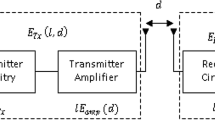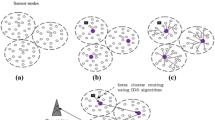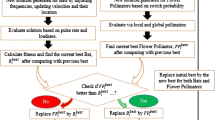Abstract
Wireless sensor devices have offered to ascend to numerous WSN applications for cost of deployment, user-friendly interface, transmitting, receiving information and observing the information through the sink hub. Few issues lead to affect the capacity of sink nodes they are, quality of service, high bandwidth demand, high energy consumption, provisioning, compressing techniques, data processing also cross-layer design. If these issues are may affect the entire system, it may create node failure. To overcome these issues,we proposean optimal emperor penguin optimization-based enhanced flower pollination algorithm for fault diagnosis and prolong network lifespan. In optimal emperor penguin optimization (OEPO) strategy is used for automatically identifying the behaviour of active sensor nodes, correcting faulted nodes and to find an optimal alternative solution for routing. Then, we illustrate the enhanced flower pollination algorithm (FPA) is proposed to extend the network's stability period. Using FPA, multi-hop communication between Cluster heads and base station is utilized to accomplish optimal link costs for load balancing of Cluster heads and energy minimization. Analysis and simulation results show that the (OEPO-FPA) proposed algorithm significantly outperforms than existing Trusted cluster based optimal multi-sink repositioning technique in terms of energy consumption,systemlifetime, delay, delivery ratio, throughput and false-positive rate.







Similar content being viewed by others
Availability of Data and Material
Not applicable.
References
Zhang, Z., Mehmood, A., Shu, L., Huo, Z., Zhang, Y., & Mukherjee, M. (2018). A survey on fault diagnosis in wireless sensor networks. IEEE Access, 6, 11349–11364.
He, W., Qiao, P. L., Zhou, Z. J., Hu, G. Y., Feng, Z. C., & Wei, H. (2018). A new belief-rule-based method for fault diagnosis of the wireless sensor network. IEEE Access, 6, 9404–9419.
Swain, R. R., & Khilar, P. M. (2017). Composite fault diagnosis in wireless sensor networks using neural networks. Wireless Personal Communications, 95(3), 2507–2548.
Swain, R. R., &Khilar, P. M. (2017). Soft fault diagnosis in wireless sensor networks using PSO based classification. In TENCON 2017–2017 IEEE Region 10 Conference (pp. 2456–2461). IEEE.
Swain, R. R., &Khilar, P. M. (2016). A fuzzy MLP approach for fault diagnosis in wireless sensor networks. In 2016 IEEE Region 10 conference (TENCON) (pp. 3183–3188). IEEE.
Zhang, Z., Shu, L., Mehmood, A., Yan, L., & Zhang, Y. (2016). A short survey on fault diagnosis in wireless sensor networks. In International Wireless Internet Conference (pp. 21–26). Springer, Cham.
Chanak, P., Banerjee, I., & Sherratt, R. S. (2016). Mobile sink based fault diagnosis scheme for wireless sensor networks. Journal of Systems and Software, 119, 45–57.
Mohapatra, S., &Khilar, P. M. (2017). Artificial immune system based fault diagnosis in large wireless sensor network topology. In TENCON 2017–2017 IEEE Region 10 Conference (pp. 2687–2692). IEEE.
Swain, R. R., Khilar, P. M., & Dash, T. (2018). Fault diagnosis and its prediction in wireless sensor networks using regressional learning to achieve fault tolerance. International Journal of Communication Systems, 31(14), e3769.
Kumar, D., Smys, S., Smilarubavathy, G., &Holzwarth, F. (2018). Fault detection methodology in wireless sensor network. In 2018 2nd International Conference on I-SMAC (IoT in Social, Mobile, Analytics and Cloud)(I-SMAC) I-SMAC (IoT in Social, Mobile, Analytics and Cloud)(I-SMAC), 2018 2nd International Conference on (pp. 723–728). IEEE.
Mohapatra, S., Khilar, P. M., & Swain, R. R. (2019). Fault diagnosis in wireless sensor network using clonal selection principle and probabilistic neural network approach. International Journal of Communication Systems, 32(16), e4138.
Swain, R. R., Dash, T., &Khilar, P. M. (2019). Investigation of RBF kernelized ANFIS for fault diagnosis in wireless sensor networks. In Computational Intelligence: Theories, Applications and Future Directions-Volume II (pp. 253–264). Springer, Singapore.
Laiou, A., Malliou, C. M., Lenas, S. A., & Tsaoussidis, V. (2019). Autonomous fault detection and diagnosis in wireless sensor networks using decision trees. JCM, 14(7), 544–552.
Mohapatra, H., & Rath, A. K. (2019). Fault-tolerant mechanism for wireless sensor network. IET Wireless Sensor Systems, 10(1), 23–30.
Mohapatra, H., & Rath, A. K. (2019). Fault tolerance in WSN through PE-LEACH protocol. IET Wireless Sensor Systems, 9(6), 358–365.
Panda, M., Gouda, B. S., &Panigrahi, T. (2020). Fault diagnosis in wireless sensor networks using a neural network constructed by deep learning technique. In Nature Inspired Computing for Wireless Sensor Networks (pp. 77–101). Springer, Singapore.
Shankar, A., Sivakumar, N. R., Sivaram, M., Ambikapathy, A., Nguyen, T. K., &Dhasarathan, V. (2020). Increasing fault tolerance ability and network lifetime with clustered pollination in wireless sensor networks. Journal of Ambient Intelligence and Humanized Computing, 1–14.
Karmarkar, A., Chanak, P., & Kumar, N. (2020). An Optimized SVM based Fault Diagnosis Scheme for Wireless Sensor Networks. In 2020 IEEE International Students' Conference on Electrical, Electronics and Computer Science (SCEECS) (pp. 1–7). IEEE.
Shamshirband, S., Joloudari, J. H., GhasemiGol, M., Saadatfar, H., Mosavi, A., & Nabipour, N. (2020). FCS-MBFLEACH: Designing an energy-aware fault detection system for mobile wireless sensor networks. Mathematics, 8(1), 28.
Kirubakaran, J., Venkatesan, G. P., Kumar, K. S., Dhanabal, S., & Baskar, K. (2020). Delay sensitive aware distributed data fault recognition algorithm for distributed sensor networks. Peer-to-Peer Networking and Applications, 13(4), 1080–1090.
Valiveti, H. B., & Rao, P. T. (2017). EHSD: An exemplary handover scheme during D2D communication based on decentralization of SDN. Wireless Personal Communications, 94(4), 2393–2416.
Premanand, R. P., &Rajaram, A. (2020). Enhanced data accuracy based PATH discovery using backing route selection algorithm in MANET. Peer-to-Peer Networking and Applications, 1–10.
Joseph, S., & Rajaram, A. (2017). Efficient secure and fair cluster routing protocol: An improved bee colony optimization cluster based efficient secure and fair routing protocol for mobile ad hoc network. Journal of Computational and Theoretical Nanoscience, 14(7), 3503–3509.
Kumar, B. and Rao, P. (2020). Trusted cluster based optimal multi-sink repositioning technique for WSNs using improved bull optimization and clonal selection algorithm. Test engineering and management, 2020/2.
Dhiman, G., & Kumar, V. (2018). Emperor penguin optimizer: A bio-inspired algorithm for engineering problems. Knowledge-Based Systems, 159, 20–50.
Funding
No funding is required for the implementation and execution.
Author information
Authors and Affiliations
Corresponding author
Ethics declarations
Conflict of interest
No conflicts of interest.
Additional information
Publisher's Note
Springer Nature remains neutral with regard to jurisdictional claims in published maps and institutional affiliations.
Rights and permissions
About this article
Cite this article
Kumar, B.S., Rao, P.T. An Optimal Emperor Penguin Optimization Based Enhanced Flower Pollination Algorithm in WSN for Fault Diagnosis and Prolong Network Lifespan. Wireless Pers Commun 127, 2003–2020 (2022). https://doi.org/10.1007/s11277-021-08765-w
Accepted:
Published:
Issue Date:
DOI: https://doi.org/10.1007/s11277-021-08765-w




